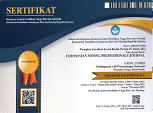Linier Superposition Analysis on Managing Blasting Ground Vibration in Coal Mining
Abstract
One of the blasting process effect is ground vibration. Ground vibration currently consider as waste energy which it can infere and be an issue to the environment. PT. Multi Nitrotama Kimia as blasting service and explosives sales in Indonesia has customers dealing with that issues, one of them is PT Adaro Indonesia. To overcome the issue, engineering approach is done to the ground vibration by changing waste energy into work energy with the principle of linear superposition using the signature hole analysis (SHA) method to minimize the ground vibration. Researches and experiments are carried out using the Signature Hole Analysis (SHA) method to record wave propagation in each range of certain blocks - strips to the concern area. The recorded waves are analyzed with the Linear Superposition feature to obtain delay time recommendation along with the predicted vibration. The recommended delay time obtained is the delay time on inter-hole and inter-row which will be applied for next blasting.Based on the Signature Hole Analysis method, the recommended delay time given can be applied to accommodate the linear superposition wave principle. Its application can be optimized using inter-deck delay to minimize ground vibration produced. Its proven by ground vibrations produced using the recommendations always below the specified standard (PVS = <2.00 mm / s).
Keywords
Full Text:
PDFReferences
________. (2010). Blastware Operator Manual Handbook. (pp. 6.35-6.58). Instantel Inc., Ottawa, Ontario, Canada.
Hustrulid. W. (1999). Blasting Principles for Open Pit Mining. (Vol. 1, pp. 272-273). A.A. Balkema, Rotterdam, Brookfield.
Yang, R., Scovira, D. S., & Patterson, N. J. (2009). “An integrated approach of signature hole vibration monitoring and modeling for quarry vibration control”. International symposium on Rock fragmentation by blasting, FRAGBLAST 9, pp. 597-605.
DOI: https://doi.org/10.36986/impj.v1i1.8
 views : 794
views : 794
Refbacks
- There are currently no refbacks.

This work is licensed under a Creative Commons Attribution-NonCommercial-ShareAlike 4.0 International License.


.png)


.png)









